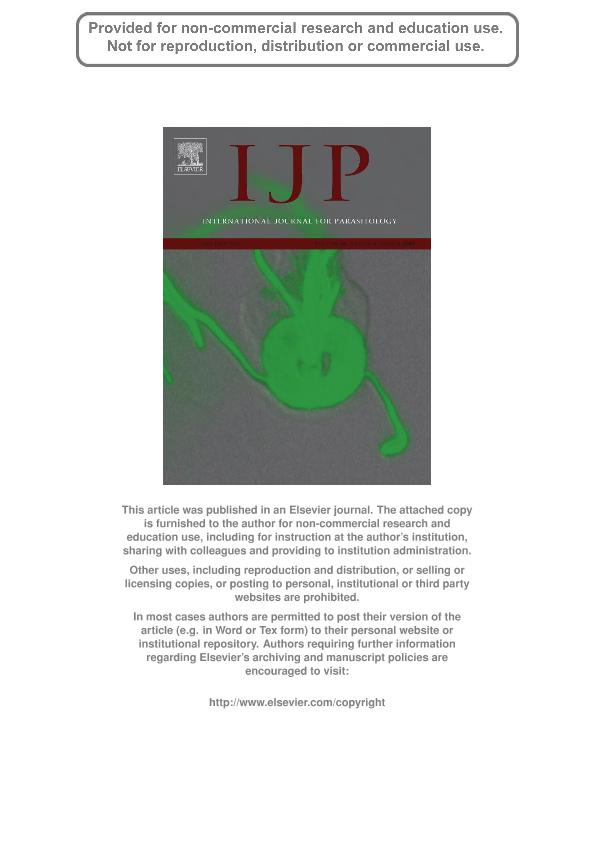Artículo
TcPARP: A DNA damage-dependent poly(ADP-ribose) polymerase from Trypanosoma cruzi
Fernandez Villamil, Silvia Hebe ; Baltanas, Rodrigo
; Baltanas, Rodrigo ; Alonso, Guillermo Daniel
; Alonso, Guillermo Daniel ; Vilchez Larrea, Salomé Catalina
; Vilchez Larrea, Salomé Catalina ; Torres, Hector Norberto
; Torres, Hector Norberto ; Flawia, Mirtha Maria
; Flawia, Mirtha Maria
 ; Baltanas, Rodrigo
; Baltanas, Rodrigo ; Alonso, Guillermo Daniel
; Alonso, Guillermo Daniel ; Vilchez Larrea, Salomé Catalina
; Vilchez Larrea, Salomé Catalina ; Torres, Hector Norberto
; Torres, Hector Norberto ; Flawia, Mirtha Maria
; Flawia, Mirtha Maria
Fecha de publicación:
03/2008
Editorial:
Elsevier
Revista:
International Journal for Parasitology
ISSN:
0020-7519
Idioma:
Inglés
Tipo de recurso:
Artículo publicado
Clasificación temática:
Resumen
Poly(ADP-ribose) polymerase (PARP) is a nuclear enzyme present in most eukaryotes and has been involved in processes such as DNA repair and gene expression. The poly(ADP-ribose) polymer (PAR) is mainly catabolised by poly(ADP-ribose) glycohydrolase. Here, we describe the cloning and characterisation of a PARP from Trypanosoma cruzi (TcPARP). The recombinant enzyme (Mr = 65) required DNA for catalytic activity and it was strongly enhanced by nicked DNA. Histones purified from T. cruzi increased TcPARP activity and the covalent attachment of [32P]ADP-ribose moieties to histones was demonstrated. TcPARP required no magnesium or any other metal ion cofactor for its activity. The enzyme was inhibited by 3-aminobenzamide, nicotinamide, theophylline and thymidine but not by menadione. We demonstrated an automodification reaction of TcPARP, and that the removal of attached PAR from this protein resulted in an increase of its activity. The enzyme was expressed in all parasite stages (amastigotes, epimastigotes and trypomastigotes). When T. cruzi epimastigotes were exposed to DNA-damaging agents such as hydrogen peroxide or β-lapachone, PAR drastically increased in the nucleus, thus confirming PAR synthesis in vivo and suggesting a physiological role for PARP in trypanosomatid DNA repair signalling.
Palabras clave:
Dna Repair Signalling
,
Parg
,
Parp
,
Trypanosoma Cruzi
Archivos asociados
Licencia
Identificadores
Colecciones
Articulos(IFIBYNE)
Articulos de INST.DE FISIOL., BIOL.MOLECULAR Y NEUROCIENCIAS
Articulos de INST.DE FISIOL., BIOL.MOLECULAR Y NEUROCIENCIAS
Articulos(INGEBI)
Articulos de INST.DE INVEST.EN ING.GENETICA Y BIOL.MOLECULAR "DR. HECTOR N TORRES"
Articulos de INST.DE INVEST.EN ING.GENETICA Y BIOL.MOLECULAR "DR. HECTOR N TORRES"
Citación
Fernandez Villamil, Silvia Hebe; Baltanas, Rodrigo; Alonso, Guillermo Daniel; Vilchez Larrea, Salomé Catalina; Torres, Hector Norberto; et al.; TcPARP: A DNA damage-dependent poly(ADP-ribose) polymerase from Trypanosoma cruzi; Elsevier; International Journal for Parasitology; 38; 3-4; 3-2008; 277-287
Compartir
Altmétricas



